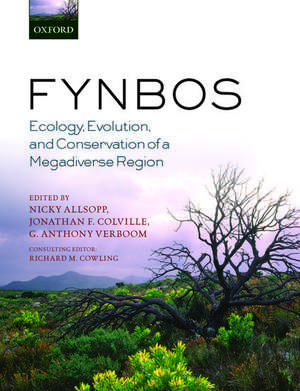Fynbos: Ecology, Evolution, and Conservation of a Megadiverse Region
Editat de Nicky Allsopp, Jonathan F. Colville, G. Anthony Verboomen Limba Engleză Paperback – 7 ian 2016
| Toate formatele și edițiile | Preț | Express |
|---|---|---|
| Paperback (1) | 388.61 lei 31-37 zile | |
| OUP OXFORD – 7 ian 2016 | 388.61 lei 31-37 zile | |
| Hardback (1) | 864.97 lei 6-8 săpt. | |
| OUP OXFORD – 17 sep 2014 | 864.97 lei 6-8 săpt. |
Preț: 388.61 lei
Preț vechi: 530.89 lei
-27% Nou
Puncte Express: 583
Preț estimativ în valută:
74.37€ • 80.75$ • 62.47£
74.37€ • 80.75$ • 62.47£
Carte tipărită la comandă
Livrare economică 12-18 aprilie
Preluare comenzi: 021 569.72.76
Specificații
ISBN-13: 9780198777762
ISBN-10: 0198777760
Pagini: 398
Dimensiuni: 190 x 248 x 23 mm
Greutate: 0.8 kg
Editura: OUP OXFORD
Colecția OUP Oxford
Locul publicării:Oxford, United Kingdom
ISBN-10: 0198777760
Pagini: 398
Dimensiuni: 190 x 248 x 23 mm
Greutate: 0.8 kg
Editura: OUP OXFORD
Colecția OUP Oxford
Locul publicării:Oxford, United Kingdom
Recenzii
[It] forms an affordable compendium of our current state of knowledge regarding this extraordinary ecoregion.
[T]he rich science and compelling natural history offered in Fynbos. Ecology, Evolution, and Conservation of a Megadiverse Region command the global conservation community to pay equal attention to this extratropical, megadiverse landscape.
[T]he rich science and compelling natural history offered in Fynbos. Ecology, Evolution, and Conservation of a Megadiverse Region command the global conservation community to pay equal attention to this extratropical, megadiverse landscape.
Notă biografică
Dr Nicky Allsopp manages the Fynbos Node of the South African Environmental Observation Network. She started her research career investigating nutrient uptake specializations of fynbos vegetation and followed this with studies of nutrient patterns and processes associated with vegetation degradation in most of the major biomes in South Africa. While working in communal rangelands, she became interested in the social dimensions of environmental management. Recently she served as an editor and author on the South African Department of Science and Technology's Global Change Research Plan. She is also involved with the Fynbos Forum which promotes science-management-decision making communication and action.Dr Tony Verboom holds an associate professorship in the Department of Biological Sciences at the University of Cape Town, teaching topics in systematics, evolutionary ecology and land plant diversity. Research-wise he is interested in questions relating to speciation, adaptation and the processes that underpin the spatial organization of biodiversity. Much of his research has involved the use of systematic tools to understand better the assembly of the modern Cape flora. To date, Dr Verboom has published 39 papers in international peer-reviewed journals. He regularly reviews for international journals and currently serves as an associate editor for Austral Ecology. He also co-edited a special issue of Molecular Phylogenetics and Evolution entitled 'Origins and evolution of a biodiversity hotspot, the biota of the African Cape Floristic Region'.Dr Jonathan Colville holds a NRF-Research Career Advancement Fellowship and is currently based at the South African National Biodiversity Institute (SANBI) within the Kirstenbosch Research Centre, where he conducts research on the ecology and evolution of South Africa's insects, as well as their conservation and value as ecosystem service providers. Most of his research focuses on investigating the patterns and processes of insect diversity, with a particular interest on the insect faunas of the Greater Cape Floristic Region, in which several insect groups show clear signatures of adaptive radiation. Dr Colville serves as an associate editor for African Entomology and is a member of the Entomological Society and Lepidopterists' Society of Southern Africa. He is an avid natural historian of insects and plants: in 2002 he was involved in the scientific discovery of the World's most recent insect order, and in 2011, he was involved in the discovery of the World's first jumping cockroach.













